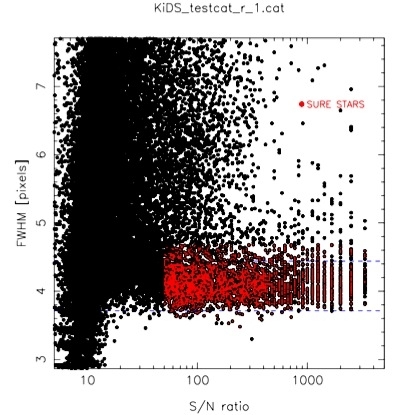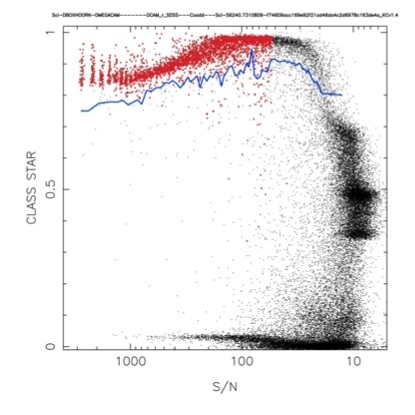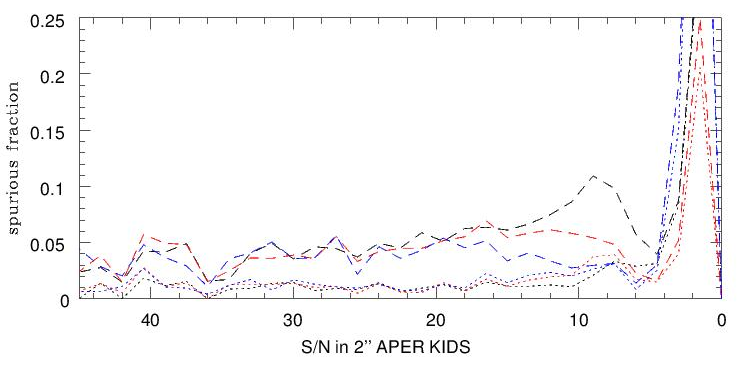Source extraction and star/galaxy separation
The source lists delivered in this data release are intended as "general purpose" source lists. Source list extraction and star/galaxy (hereafter S/G) separation is done with an automated stand-alone procedure optimized for KiDS data: KiDS-CAT. This procedure, the backbone of which is formed by S-Extractor (Bertin & Arnouts, 1996, A&AS, 317, 393) performs the following steps.
- S-Extractor is run on the stacked image to measure the FWHM of all sources. High-confidence star candidates are then identified (for details see La Barbera et al. 2008, PASP, 120, L681).
- The average PSF FWHM is calculated by applying the bi-weight location estimator to the FWHM distribution of the high-confidence star candidates.
- A second pass of S-Extractor is done with SEEING_FWHM set to the derived average PSF FHWM. During this second pass the image is background-subtracted, filtered and thresholded "on-the fly". Detected sources are then de-blended, cleaned, photometered, and classified. A number of S-Extractor input parameters are set individually for each image (e.g., SEEING_FWHM and GAIN), while others have been optimized to provide the best compromise between completeness and spurious detections (see Data Quality section below). The detection set-up used is summarized in the table below; a full S-Extractor config file is available via the following link: Example S-Extractor configuration file
Apart from isophotal magnitudes and Kron-like elliptical aperture magnitudes, a large number of aperture fluxes are included in the source lists. This allows users to estimate aperture corrections and total source magnitudes. All parameters provided in the source lists are listed in the Data Format section below. - S/G separation is performed based the CLASS_STAR (star classification) and SNR (signal-to-noise ratio) parameters provided by S-Extractor and consists of the following steps:
- In the SNR range where the high-confidence star candidates are located (the red dots in the figure below) the bi-weight estimator is used to define their CLASS_STAR location, θ, and its width, σ; a lower envelope of θ − 4σ is defined.
- At SNR below that of the high-confidence star candidates, a running median CLASS_STAR value is computed from sources with CLASS_STAR > 0.8, which is shifted to match the θ − 4σ locus. The resulting curve (blue curve in the figure below) defines the separation of stars and galaxies.
The source magnitudes and fluxes in the final source lists are not corrected for Galactic foreground or intergalactic extinction. The result of the S/G classification is available in the source lists via the 2DPHOT flag. Flag values are: 1 (high-confidence star candidates), 2 (objects with FWHM smaller than stars in the stellar locus, e.g., some cosmic-rays and/or other unreliable sources), 4 (stars according to S/G separation), and 0 otherwise (galaxies); flag values are summed, so 2DPHOT = 5 signifies a high-confidence star candidate that is also above the S/G separation line.
NOTE: source lists with a higher detection threshold (DETECT_THRESH = 2.0) are also available via the Astro-WISE portal.
| Parameter | Value | Description |
|---|---|---|
| DETECT_THRESH | 1.5 | <sigmas> or <threshold>,<ZP> in mag.arcsec-2 |
| DETECT_MINAREA | 3 | minimum number of pixels above threshold |
| ANALYSIS_THRESH | 1.5 | <sigmas> or <threshold>,<ZP> in mag.arcsec-2 |
| DEBLEND_NTHRESH | 32 | Number of deblending sub-thresholds |
| DEBLEND_MINCONT | 0.001 | Minimum contrast parameter for deblending |
| FILTER | Y | Apply filter for detection (Y or N) |
| FILTER_NAME | default.conv | Name of the file containing the filter |
| CLEAN | Y | Clean spurious detections? (Y or N)? |
| CLEAN_PARAM | 1.0 | Cleaning efficiency |
| BACK_SIZE | 256 | Background mesh: <size> or <width>,<height> |
| BACK_FILTERSIZE | 3 | Background filter: <size> or <width>,<height> |
| BACKPHOTO_TYPE | LOCAL | can be "GLOBAL" or "LOCAL" |
| BACKPHOTO_THICK | 24 | thickness of the background LOCAL annulus |
| Note: example of complete S-Extractor configuration file | ||
Completeness and contamination
The contamination of the KiDS-ESO-DR1 source lists for unflagged sources is estimated to be <4% down to a SNR~5 within a 2 arcsec aperture (see the figure below). Ignoring all source extraction flags and masking, the corresponding spurious fraction increases to at most 10%. At very low SNR (<3), the spurious fraction increases dramatically, and we advise users of the source lists to filter out all sources below a SNR threshold of 3.0.
The spurious fractions are determined through a comparison to the r-band data of the CFHT Legacy Survey, the main deeper survey overlapping with the current release (CFHTLS-W2, using their final data release T0007). For the analysis it is assumed that all KiDS sources not detected in CFHTLS-W2 are spurious. These values come with a caveat: they were only determined accurately in r-band and for a small area (< 1 sq.deg.).
An internal estimate of the completeness for KiDS-ESO-DR1 source lists is provided, based on the method of Garilli et al. 1999 (A&A, 342, 408). It determines the magnitude at which objects start to be lost in the source list because they are below the brightness threshold in the detection cell. The implementation is similar to La Barbera et al. (2010, MNRAS, 408, 1313). Estimates of the completeness obtained by comparison to deeper CFHTLS-W2 data are consistent with these internally derived values. The distributions of the 98% completeness magnitudes for all tiles are shown in the data quality section. Comparison with the limiting magnitudes shows that the 98% completeness limits are typically ~1 magnitude brighter than the limiting magnitude for g, r and i and ~1.3 magnitudes brighter in u.



